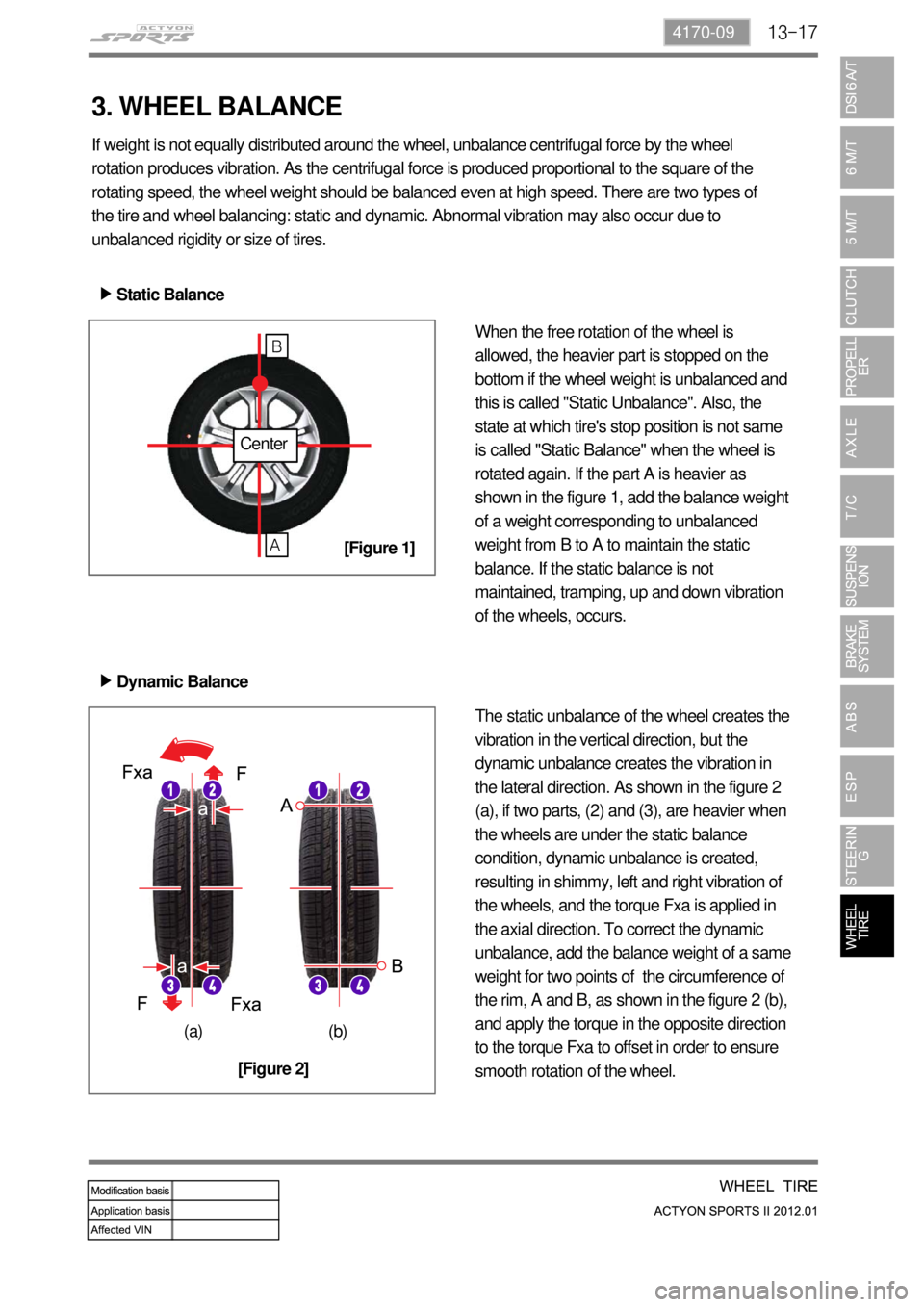Page 750 of 828
13-94170-09
Wheel balance 5.
Check the wheel balance when the
wheel is unbalanced or the tire is
repaired.
The total weight of the wheel weight
should not exceed 150 g.
Ensure that the balance weight installed
is not projected over 3mm from the
wheel surface.
Use the specified aluminum wheel
balance weights for aluminum wheels.
Weight balance can be added by 5 g.
There are two types of weight balance,
tape type and adhesion type. -
-
-
-
-
-
Make sure to read the manual of the
manufacturer thoroughly before using
wheel balance tester. -
Change tire location
To avoid uneven wear of tires and to
prolong tire life, inspect and rotate your
tires every 5,000 km. 6.
Mixing tires could cause to lose control while driving. Be sure to use the same size and type
tires of the same manufacturer on all wheels. -
Page 754 of 828

13-134170-09
Structure of Tire ▶
Tread
This thick layer of rubber provides the interface between the tire and the road. Wear-resistant
rubber is used to protect the carcass and belt against fractures and impacts and to deliver a long
driving life.
Shoulder
Located between the tread and sidewall, the shoulder rubber is the thickest so that the design
must allow for the easy diffusion of heat generated within the tire while driving.
Sidewall
The part between the shoulder and bead, the flexible sidewall protects the carcass and enhances
the ride. A tire’s ty
pe, size, structure, pattern, manufacturing company, product name and various
characters are indicated here.
Bead
The bead attaches the tire to the rim and wraps the end of the cord fabric. Comprised of the
bead wire, core, flipper and other parts, the bead is generally designed to be slightly tight around
the rim so that in the case of a sudden drop in inflation pressure, the tire will not fall off the rim.
Carcass
As the most important framework of a tire, the entire inner layer of cord fabric is called the
carcass. The carcass acts to support air pressure, vertical load and absorb shocks.
Page 758 of 828

13-174170-09
If weight is not equally distributed around the wheel, unbalance centrifugal force by the wheel
rotation produces vibration. As the centrifugal force is produced proportional to the square of the
rotating speed, the wheel weight should be balanced even at high speed. There are two types of
the tire and wheel balancing: static and dynamic. Abnormal vibration may also occur due to
unbalanced rigidity or size of tires.
Static Balance ▶
When the free rotation of the wheel is
allowed, the heavier part is stopped on the
bottom if the wheel weight is unbalanced and
this is called "Static Unbalance". Also, the
state at which tire's stop position is not same
is called "Static Balance" when the wheel is
rotated again. If the part A is heavier as
shown in the figure 1, add the balance weight
of a weight corresponding to unbalanced
weight from B to A to maintain the static
balance. If the static balance is not
maintained, tramping, up and down vibration
of the wheels, occurs.
Dynamic Balance ▶
The static unbalance of the wheel creates the
vibration in the vertical direction, but the
dynamic unbalance creates the vibration in
the lateral direction. As shown in the figure 2
(a), if two parts, (2) and (3), are heavier when
the wheels are under the static balance
condition, dynamic unbalance is created,
resulting in shimmy, left and right vibration of
the wheels, and the torque Fxa is applied in
the axial direction. To correct the dynamic
unbalance, add the balance weight of a same
weight for two points of the circumference of
the rim, A and B, as shown in the figure 2 (b),
and apply the torque in the opposite direction
to the torque Fxa to offset in order to ensure
smooth rotation of the wheel.
Center
A
B
(a) (b)
[Figure 1]
[Figure 2]
3. WHEEL BALANCE